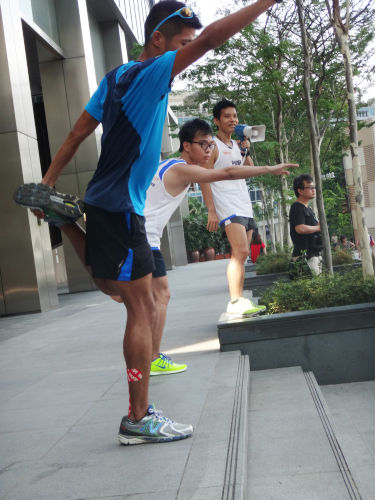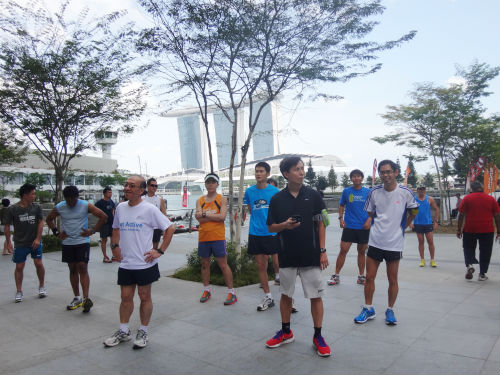To prepare runners for the NTUC Income Run 350 on 27 April, top local runner Marcus Ong imparted his knowledge to participants, through a talk cum running clinic.
Marcus is a seasoned runner and won the Standard Chartered Marathon Singapore (Ekiden category) last year.
Click here to read more about the tips (in Part 1) that Marcus shared during the talk.
Participants were also invited to field questions in a Q&A session. Read on to find out how Marcus answered these.
Marcus, how do you overcome your injuries efficiently?
I do intensive core exercises on my stomach and back. When I strengthen these parts of my body, the knots in my legs will untangle themselves.
My recent Achilles tendon injury, sustained during the Standard Chartered Marathon Singapore (Ekiden) last year, was the worst one for me so far, as it meant absolutely no running for four weeks – but I did regular exercises.
Can you impart some tips to running faster?
Intensive training is very important. You must be able to push yourself to your maximum capacity. But it is crucial to get a good running base first and slowly build up the distance to your desired amount.
Some basic exercises that you should do to improve your lower body and leg strength, include one-leg hops, high knee lifts and butt kicks.
How do I know whether the pain I feel during running is causing me more injuries?
If it feels very painful, you should definitely stop running. For me, I base it on this analogy. If the pain makes me sweat profusely during the run, I stop running. But if I can still bear with it, then I will just keep on running.
How can I prevent blisters when I am running?
Try to wear thick socks.
For me, I wear two layers of socks – this would be a thin pair and then another thicker one on top. As well, using anti-flaming gels and plaster underneath the socks will further help to prevent feet blisters during your run.
How would you advise a first-time runner on his or her first race?
Try to see the race as being enjoyable. Do not have any timing requirements for yourself – otherwise you will only get more stressed.
It will take about one month to build stamina for a 10km race and you must also try to enjoy this process of increasing your mileage. But do not cut back on your exercise and running routine if you are busy. Try and squeeze in time to train regularly. For me, I work 10 to 12 hours per day and I struggle with running commitments. But I am still able to manage. If I can, then you should also be able to.
What is your weekly training schedule like?
I split my training into odd and even days.
On Monday, Wednesday and Friday, I will do aerobic exercises. Then on Tuesday and Thursday, I concentrate more on speed. My focus for workouts is quality and not quantity.
I usually train late at night when nobody is around – this would typically be at 11pm on a sports and recreational track near the Botanic Gardens, because it is one of the few that is operating 24/7.
What is your own running style, Marcus?
I am a mid to front foot runner, because this is more efficient. I don’t want to land on my heels, because I have heard that this causes more injuries. I was originally a heel runner until I made the transition, but this transition process took years of practice.
My training mostly consists of doing drills, and I believe that these drills will help your forefoot striking even better. However, you should wear heavily padded shoes for your training sessions, because light shoes will increase your chances of injury as a forefoot runner. But to improve my speed during races, I wear light shoes.
Click here for Marcus Pre Race and Post Race Tips (Part 1).




Leave a Comment